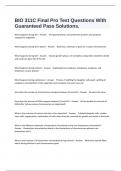Exam (elaborations)
BIO 311C Final Pro Test Questions With Guaranteed Pass Solutions.
- Course
- Institution
What happens during G1? - Answer First growth phase; cell synthesizes proteins and produces cytoplasmic organelles What happens during the S phase? - Answer Synthesis; continues to grow as it copies chromosomes What happens during G2? - Answer Second growth phase; cell completes prep...
[Show more]



